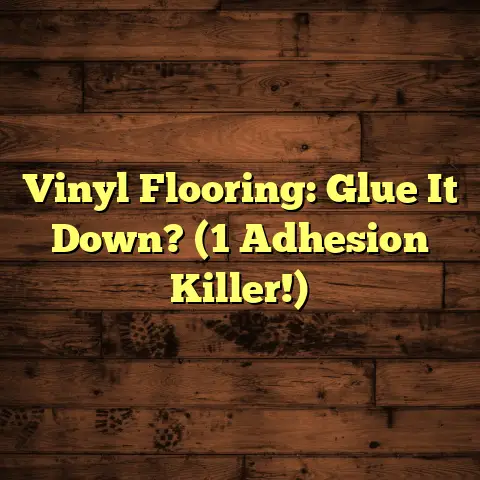Maintain Garden Paths Like a Pro? (3 Fixes Now!)
I’m excited to talk about something near and dear to my heart – garden paths!
As a flooring contractor for over 15 years, I’ve seen it all, from crumbling concrete to weed-infested walkways.
And let me tell you, a well-maintained garden path can transform your entire outdoor space.
It’s not just about getting from point A to B; it’s about creating an experience, a journey through your own little slice of paradise.
Riding the Wave of Garden Design Trends
These days, outdoor spaces are becoming more and more like extensions of our homes.
Think outdoor kitchens, cozy seating areas, and, of course, stunning garden paths.
People are really investing in making their gardens beautiful and functional.
Sustainability is Key:
One of the biggest trends I’m seeing is the push for sustainable gardening.
Homeowners are choosing eco-friendly materials like recycled pavers, permeable gravel, and reclaimed wood.
These options not only look great but also help reduce your environmental impact.
Paths with Purpose:
Garden paths are no longer just walkways.
They’re decorative elements that guide the eye, create visual interest, and contribute to the overall garden design.
I’ve seen paths that double as seating areas, with built-in benches or stepping stones that lead to hidden garden nooks.
Section 1: The Importance of
Well-Maintained Garden Paths
Think of your garden path as the backbone of your landscape design.
It provides accessibility, ensures safety, and enhances the overall aesthetic appeal of your outdoor space.
Accessibility and Usability:
A well-defined path makes your garden more accessible to everyone, regardless of age or mobility.
It encourages you to explore your garden, spend more time outdoors, and truly enjoy your surroundings.
Safety First:
A cracked or uneven path can be a serious tripping hazard.
Maintaining your paths ensures the safety of your family, friends, and visitors.
Boosting Curb Appeal:
Let’s face it, a beautiful garden path adds instant curb appeal to your home.
It creates a welcoming entrance and makes a statement about your personal style and attention to detail.
According to a recent survey by the American Society of Landscape Architects, 83% of homeowners believe that a well- maintained landscape increases property value.
Section 2: Common Issues with
Garden Paths
Okay, let’s get down to the nitty-gritty.
What are the most common problems homeowners face with their garden paths?
Weed Infestation:
Weeds are the bane of every gardener’s existence, and they can quickly take over your paths if left unchecked.
Settling and Cracking:
Over time, paths can settle, crack, or become uneven due to soil erosion, weather conditions, or poor installation.
Drainage Dilemmas:
Poor drainage can lead to a host of problems, including erosion, water damage, and the growth of moss and algae.
Consequences of Neglect:
Ignoring these issues can have serious consequences:
- Decreased curb appeal
- Safety hazards (tripping, slipping)
- Damage to surrounding plants
- Costly repairs down the road
Section 3: Fix #1 – Weed Control
Alright, let’s tackle the weed problem head-on!
I’m talking about effective weed control methods tailored for garden paths.
Prevention is Key:
The best way to deal with weeds is to prevent them from growing in the first place.
Here are a few preventative measures I recommend:
-
Landscape Fabric:
This is a must-have for any garden path.
It acts as a barrier, preventing weeds from sprouting while still allowing water and nutrients to reach the soil.
I like to use a heavy-duty, woven fabric for maximum effectiveness.
-
Mulch:
A layer of mulch can help suppress weed growth by blocking sunlight and smothering existing weeds.
Organic mulches like wood chips, shredded bark, or compost also enrich the soil as they decompose.
-
Pre-Emergent Herbicides:
These herbicides prevent weed seeds from germinating.
I recommend using a pre-emergent herbicide in early spring before weeds start to sprout.
Reactive Measures:
Even with the best preventative measures, weeds can still pop up from time to time.
Here are a few reactive measures you can take:
-
Hand-Pulling:
For small infestations, hand-pulling is the most effective method.
Make sure to remove the entire root system to prevent the weed from growing back.
-
Post-Emergent Herbicides:
These herbicides kill existing weeds.
I recommend using a selective herbicide that targets specific weeds without harming your desirable plants.
Important: Always follow the manufacturer’s instructions carefully when using herbicides.
-
Boiling Water or Vinegar:
These are natural alternatives to herbicides.
Pour boiling water or undiluted white vinegar directly onto the weeds to kill them.
Be careful not to get these solutions on your desirable plants.
Step-by-Step Weed Control:
-
Prepare the Area:
Clear the path of any debris, leaves, or loose soil.
-
Install Landscape Fabric:
Lay down landscape fabric, overlapping the edges by at least 6 inches.
Secure the fabric with landscape staples.
-
Apply Mulch:
Spread a 2-3 inch layer of mulch over the landscape fabric.
-
Monitor and Maintain:
Regularly inspect the path for weeds and take action as needed.
Reapply mulch as needed to maintain a thick layer.
Section 4: Fix #2 – Repairing Settled
or Cracked Paths
Settling and cracking are common problems, but they’re usually easy to fix.
Identifying the Problem:
First, you need to determine the extent of the damage.
Are there just a few small cracks, or is the path significantly uneven?
Materials and Approaches:
The repair method will depend on the material of your path:
-
Stone Paths:
For settled stones, carefully remove the stones and level the base with sand or gravel.
Replace the stones, making sure they’re level and stable.
For cracked stones, you may need to replace them with new ones.
-
Concrete Paths:
For small cracks, you can use a concrete patching compound.
Clean the area thoroughly and apply the patching compound according to the manufacturer’s instructions.
For larger cracks or uneven sections, you may need to remove and replace the affected area.
-
Brick Paths:
For settled bricks, remove the bricks and level the base with sand.
Replace the bricks, making sure they’re level and aligned.
For cracked bricks, replace them with new ones.
Leveling Techniques:
-
Sand or Gravel Base:
A solid base is essential for preventing settling.
Use a layer of compacted sand or gravel as a base for your path.
-
Compacting:
Use a hand tamper or plate compactor to compact the base material.
This will help create a stable foundation for your path.
Blending Repairs:
-
Matching Materials:
When replacing stones or bricks, try to match the existing materials as closely as possible.
-
Feathering Edges:
When patching concrete, feather the edges of the patch to blend it seamlessly with the existing concrete.
Section 5: Fix #3 – Improving Drainage
Proper drainage is crucial for the longevity of your garden path.
Why Drainage Matters:
Poor drainage can lead to:
- Erosion
- Cracking
- Water damage
- Safety hazards (slipping)
Methods to Improve Drainage:
-
French Drains:
These are underground drainage systems that collect and redirect water away from your path.
I often recommend installing French drains along the edges of the path.
-
Adjusting the Slope:
Make sure your path has a slight slope to allow water to run off.
A slope of 1-2% is usually sufficient.
-
Permeable Paving Materials:
These materials allow water to drain through them, reducing runoff and preventing water from pooling on the surface.
Examples include:
- Gravel
- Permeable pavers
- Decomposed granite
Assessing Drainage Issues:
-
Observe Water Flow:
Pay attention to how water flows during and after rain.
Are there any areas where water tends to pool?
-
Check for Erosion:
Look for signs of erosion along the edges of the path.
-
Inspect for Cracking:
Cracks can indicate that water is seeping underneath the path and causing damage.
Implementing Solutions:
-
Install French Drains:
Dig a trench along the edge of the path.
Line the trench with landscape fabric.
Fill the trench with gravel and a perforated pipe.
Cover the pipe with more gravel and landscape fabric.
Backfill the trench with soil.
-
Adjust the Slope:
Add or remove soil to create a slight slope away from the path.
-
Replace Impermeable Materials:
Replace concrete or asphalt with permeable paving materials like gravel or permeable pavers.
Conclusion
Maintaining your garden paths is an investment in the beauty, functionality, and sustainability of your outdoor space.
By implementing these three fixes, you can create a welcoming and enjoyable environment for yourself, your family, and your guests.
So, what are you waiting for?
Get out there and start enhancing your garden paths today!
I hope this article has helped provide some useful information.
Until next time, happy gardening!





